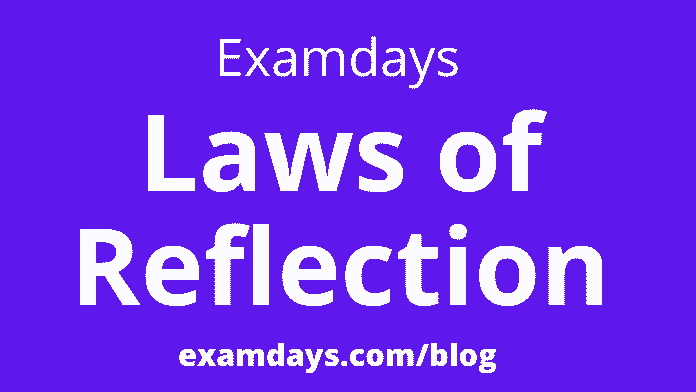Reflection: The process of sending back the light rays that fall on a polished surface is called reflection of light. Reflection is a sudden change in the direction of propagation of a wave striking a boundary between different media. At least part of the incoming wave disturbance remains in the same medium.
Normal reflection, which follows a simple law, occurs at plane boundaries. The angle between the direction of the incoming wave and the perpendicular to the reflecting surface is equal to the angle between the perpendicular (angle of reflection) and the direction of the reflected wave.
Reflection is when a body throws light or sound back without being absorbed. So reflection occurs when light or sound (resonance in the case of sound) bounces off a surface without being absorbed by the surface.
Laws of reflection
The law of reflection shows the reflection of light rays from smooth and polished surfaces. The angle of incidence and reflection occurs such that the incident ray, the reflected ray, and the normal ray to the surface at the point of incidence all lie in the same plane.
3 Laws of Reflection
These laws were proposed by Euclid, who stated that
(i) The angle of reflection is always equal to the angle of incidence.
(ii) The incident rays, reflected rays, and the normal all lie in the same plane.
i) The angle of reflection is always equal to the angle of incidence:
Equal angles of incidence and reflection or bounce are not a property unique to light but a universal phenomenon common to all objects regardless of mass, velocity, and volume under ideal conditions without gravity and atmospheric resistance.
Let’s analyze with the ‘Y’ and ‘X’ axes. Moments have two parts. One is along and parallels the X-axis, and the other is parallel to the Y-axis in the vertical direction. Apply the law of conservation of momentum here, where when the vertical angle to the plane of incidence on the Y axis is reversed, the angle of incidence from the origin on the X axis is not perturbed.
When an object is ejected at an angle of 30* degrees along the Y axis to the point of incidence, the motion of the Y-axis component is conserved by rebounding in the opposite direction. But the undisturbed part on the X axis travels in the same plane on the X axis by pulling the object with the same speed towards the Y axis in the opposite direction at the same angle by conserving the momentum of the Y and X axis.
who gave laws of reflection?
Still, the Y-axis component moves in the reverse direction at a constant speed, both on the axis at a consistent pace and in the reverse direction, in the absence of any resistance by fully obeying the law of conservation of momentum in the reverse direction. In Snooker, Billiards, and Carroms, the chances of winning are high if you follow the same principle. Therefore, the equal angles of incidence and rebounding are not unique to light but are common to all objects in motion.
laws of reflection and refraction
ii) The incident rays, reflected rays, and the normal all lie in the same plane:
A plane is a flat surface. When a ray of light strikes this flat surface, the ray is called an incident ray. When this incident ray hits the plane, it forms a reflected ray. A normal is a line drawn perpendicular to the plane, bisecting the angle formed by the incident and the reflected ray.
Now, the incident ray can’t be in one plane and the same reflected ray in another plane because light always bounces off at the point of incidence. Nor can the normal be in a different plane because it always divides at the point of incidence.
Therefore, the incident ray, the reflected ray of the same incident ray, and the normal always lie in the same plane.
What is a reflected ray?
The ray of light traveling from a surface where the incident ray strikes a surface is known as the Reflected ray.
Conclusion:
Reflection: The process of sending back the light rays that fall on a polished surface is called reflection of light.
Laws of reflection:
(i) The angle of reflection is always equal to the angle of incidence.
(ii) The incident, reflected rays, and the normal all lie in the same plane.
We have covered the maximum number of infomation about the 3 laws of refelection
Examdays Article Agenda

